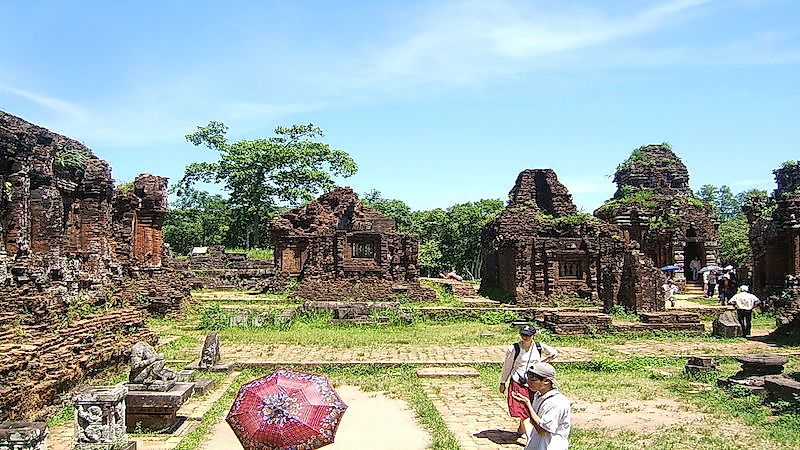UNESCO World Heritage Sites In Vietnam

Vietnam has five cultural, two natural, and one mixed site listed by UNESCO as World Heritage Sites, emphasizing its rich culture and biodiversity. These landscapes attract millions of local and foreign tourists annually. Every part of the country has something medieval or colonial to offer to its visitors. From the famous Complex of Hue to the mixed heritage of Trang An Landscape Complex, the country is a wonder with cities dating back to several years.
Complex Of Hue Monuments
Hue was established as the capital of Vietnam in 1802 as the only political, cultural, and religious center under the last Ngunyen Royal Dynasty. The Complex of Hue Monuments in Hue city is in the Thua Thien-Hue Province accessible from the sea.The city’s natural beauty comes from the Ngu Binh Mountain and the Perfume River running through the city. The complex of Hue Monument is famous for the Belvedere of the Five Phoenixes where the emperor appeared during royal occasions. Hue Citadel was the administrative center of Southern Vietnam in the 17th and 18th century.The Tran Binh Dai was designed to control the flow of the river, and Tran Hai Thanh was constructed to protect the capital from any sea assault. The government owns the Complex of Hue Monuments. The natural site is protected by the 1972 Convention which aims to preserve the world cultural heritage. The Socio-Economic Development Plan of Thua Thien Hue Province plans to conserve and protect the monument through 2020. In 1993, UNESCO named it as a cultural heritage site.
Ha Long Bay
UNESCO listed Ha Long Bay as a natural heritage site in 1994. Located in the Gulf of Tonkin in Quang Ninh Province, the scattered islands of Dinh Huong with spiritual significance, Ga Choi is Vietnam’s tourism symbol, Con Coc the medieval ages are a major tourist destination by people all over the world. It has a total of about 1,600 islands, and the islets have a total area of about 4,300 hectares.The site has limestone karst landforms with spectacular coastal erosion pillars, caves, and arches. It provides romantic getaways with people traveling to see the beauty of the 20th century in La Long Bay. In addition to being a UNESCO recognized site, it is also a natural wonder of the world since 2012 as per the New 7 Wonders poll.
Hoi An Ancient Town
UNESCO declared the peaceful old town of Hoi An as a Heritage site thanks to the unique blend of local, foreign, and medieval influences in 1999. In the 15th to 19th century, the small town was a Southeast Asian trading port. Most of the buildings in the ancient city have a traditional architectural design of the 19th and 20th century. The site located in Quang Nam Province is a major tourist destination and foreign investors invest heavily here, thanks to the fused cultures in an international maritime commercial center.
My Son Sanctuary
My Son Sanctuary was designated as a World Heritage Site in 1999 for its impressive tower-temples of the Indian Hindu design, belonging to the Champa Kingdom. My Son possesses 71 monuments and 32 epitaphs of the long gone centuries. The site's history dates back to the 4th through the 13th centuries as the heart of the Champa kingdom. The site was also the spiritual center of the Champa people.
Phong Nha-Ke Bang National Park
This site is located in Annamite Mountain Range in Quang Binh, central Vietnam. UNESCO listed the site as a World Heritage Site in 2003. The impressive karst formation, the oldest major karst in Asia has spectacular formations such as a 65km cave and underground rivers. The Phong Nha cave and the Ke Bang forest give this natural site a look of heaven in the jungle. The caves have Neolithic ax heads and artifacts representing the oldest evidence of human occupation. Relics of Ham Nghi King, the last king of the Nguyen Dynasty just before the French colonization, are found in the Maria Mountains north of the park. The site is famous as a religious and tourist attraction site and the caves conceal a Champ temple used for worship in the 9th-10th centuries. The Cave of Phong Nha and the Ke Bang forests were a garrison and weapon store of the Vietnamese army during the war with the USA. The site is highly conserved as part of the continuous forest block of Him Namno Biodiversity Conservation Area.
The Beauty Of Vietnam
Other heritage sites in the area are the cultural Imperial Citadel of Thang Long (listed in 2010), and Trang An Landscape Complex of mixed heritage in 2014. The imperial cultural site was built during the Ly rule and expanded during the dynasties of Tran, Le, and Nguyen. The Trang An Landscape Complex is both a natural and cultural heritage site. The limestone formations, valleys, and cliffs are the natural part of the place while the temples, paddy fields, pagodas, villages and shrines dating back to several centuries forms the cultural side. In general, Vietnam has a great collection of historic sites. The country has a profound religious past with almost every site having a shrine or a temple. Tourists travel to Vietnam to see the beautiful natural sceneries that have survived the hands of time. The government takes pride in having implemented significant measures to protect these ancient places from the rampant growth and activities of the current civilization.
UNESCO World Heritage Sites In Vietnam
| UNESCO World Heritage Sites in Vietnam | Type, Year of Inscription |
|---|---|
| Complex of Hué Monuments | Cultural, 1993 |
| Ha Long Bay | Natural, 1994 |
| Hoi An Ancient Town | Cultural, 1999 |
| My Son Sanctuary | Cultural, 1999 |
| Phong Nha-Ke Bang National Park | Natural, 2003 |
| Imperial Citadel of Thang Long | Cultural, 2010 |
| Trang An Landscape Complex | Mixed, 2014 |











